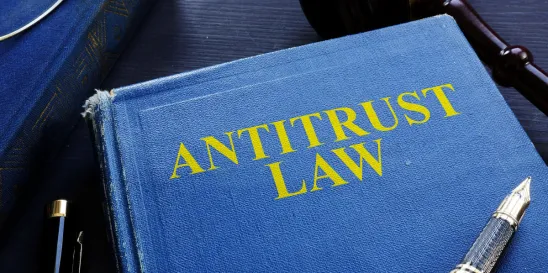On October 5, 2023, the Brookings Institution hosted an event entitled “A conversation with FTC Chair Lina Khan and DOJ Assistant Attorney General Jonathan Kanter on antitrust enforcement.” The discussion was moderated by the Honorable Bill Baer, Former Assistant Attorney General for the U.S. Department of Justice, Antitrust Division (the “Division”) under President Obama. Khan and Kanter discussed the challenges and opportunities of their respective tenures during the Biden administration. Both agency leaders pledged to focus on deterrence in both consumer and labor markets, consistent with the changes proposed to modernize the Merger Guidelines and Hart-Scott-Rodino (HSR) Act filing form.
Antitrust Successes of the Biden Administration
Kanter opened the dialogue by recalling “the core fundamental values” of antitrust law, which he described as supporting workers and fostering upward mobility. He cited the Division’s successful monopsony case against Penguin Random House’s acquisition of Simon & Schuster[1] and two criminal monopoly cases[2] as proof of this commitment. Pointing to the impact outside the courtroom, Khan took pride in what she deems increased deterrence and the fact that assessments of antitrust risk are happening before a transaction is announced rather than being considered later in the acquisition process.
Both speakers implicitly acknowledged that not all of their efforts have resulted in success in court, but, as Kanter said, “the narrative that we are losing cases is wrong.” Nonetheless, he reasoned that “it is our job to learn from every experience.” Khan remarked that the FTC has blocked 20 deals and, although the cases were not always won in court, the judicial opinions contain important guidance on mergers in digital markets. Additionally, “numerous” transactions were abandoned after being blocked.
Kanter and Khan Emphasize the Value of Deterrence
To Kanter and Khan, the future of antitrust enforcement is deterrence. From Kanter’s vantage point, “some transactions should not leave the Boardroom.” Khan deems deterrence to be a “key goal” of antitrust enforcement and seems undaunted by the FTC’s mixed enforcement record because the value of deterrence “speaks for itself.”
It appears that the Division and FTC will continue to espouse theories and pursue cases that some commentators consider beyond the traditional bounds of antitrust law. Kanter and Khan indicated that pushing the envelope and losing in court is not a waste of time or resources if it means that companies and individuals will reconsider problematic deals and unlawful agreements in their nascent stages. The issue is how to measure effective deterrence of anticompetitive conduct against discouraging deals and contracts that are legal but stymied by concerns that the agencies will nonetheless challenge them. Simply put, for the reasons set forth below, increased uncertainty in antitrust enforcement will continue for the foreseeable future.
The Draft Updated Merger Guidelines and HSR Form Reflect New Market Realities
Kanter noted that “a lot has changed” since the Merger Guidelines were first published in 1982. According to Kanter, the draft updated Merger Guidelines are organized around new market realities so as “not to miss things.” Khan maintained that even if the updated Merger Guidelines require “a lot of analytical work on the front end,” the parties will know from the beginning “the key dimensions that anchor the analysis” as the transaction goes through the merger review process. Khan also addressed the inclusion of case citations in the updated Merger Guidelines, asserting that the citations show that purportedly “new” principles are grounded in precedent. The agencies have received over 4,000 comments from bar associations, workers, farmers, and small business owners, and, according to Khan, “overwhelmingly the majority support the direction of the guidelines.” Neither Khan nor Kanter would commit to the timing of the final updated Merger Guidelines but assured the audience they are “working as quickly as we can.”
In a similar vein, Khan noted that the HSR filing form had not been updated in 45 years, and, as a result, the agencies are not getting information that they need to assess competition in today’s markets. Khan did not specify how the current HSR filing form is inadequate, but the updated version, if adopted, would provide information to evaluate a transaction’s competitive effects in the relevant labor markets. Kanter also insisted that asking questions pertaining to market analysis was more faithful to congressional intent and the purpose of the HSR Act than keeping the status quo.
The Agencies View Labor Markets as a “High Priority”
While the Division has historically brought consumer price cases, Kanter indicated that unlawful labor market agreements are now fair game. Specifically, and despite mixed success in court, the Division will continue to prosecute no-poach agreements, pursuant to which competitors agree not to hire each other’s employees. Khan similarly justified the FTC’s efforts to outlaw non-compete agreements by arguing that they affect not only the workers bound by those agreements but the market as a whole—for example, start-ups that could lessen market concentration are prevented from securing talented employees needed to compete against entrenched dominant companies because they are “locked” into their jobs.
An Aggressive Antitrust Enforcement Agenda Creates Uncertainty
Kanter views combatting harm in the labor market as “foundational to the work we are doing in the merger and non-merger context,” citing Judge Easterbrook’s recent opinion vacating the district court’s dismissal of a complaint brought by McDonald’s employees who were prevented from accepting higher paying, managerial positions at other McDonald’s franchises due to no-poach agreements.[3] Khan echoed this sentiment when she stated that despite the agencies’ great reliance on economic tools, merger review is a “law enforcement exercise.” The conversation at the Brookings Institution made clear that Kanter and Khan consider protecting the rights of workers an integral part of antitrust enforcement—a controversial theory that will create years of uncertainty for businesses as the legality of this position is tested in the courts.
Key Takeaways
- Kanter and Khan describe their respective enforcement agendas as supporting workers and fostering upward mobility by combatting market concentration through the updated Merger Guidelines, the updated HSR form, and pursuing labor market cases.
- The Division and the FTC view deterrence is a “key goal” of antitrust enforcement. They are more concerned with discouraging transactions that “should not leave the Boardroom” than prevailing in court. Even if an agency challenge is not successful, the reasoning in the judicial opinions provides importance guidance for the next case.
- From the vantage point of Kanter and Khan, the updated Merger Guidelines will provide “the key dimensions that anchor the analysis” in the merger review process, and the updated HSR form will more accurately capture a transaction’s competitive effects.
- The agencies will target unlawful no-poach and non-compete agreements, reasoning that these contracts lock workers into jobs with entrenched dominant companies.
- Kanter and Khan indicated that they would continue to test new theories and bring cases beyond the bounds of traditional antitrust law, increasing uncertainty for businesses and executives.
FOOTNOTES
[1] See U.S. v. Bertlesmann SE & Co. KGaA, Case 1:21-cv-02886-FYP (D.D.C. Nov. 7, 2022).
[2] See U.S. v. Zito, No. 1:22-cr-00113-SPW (D. Mont. Oct. 31, 2022) (defendant tried to divide the market for publicly funded crack-sealing projects in Montana and Wyoming); U.S. v. Martinez, No. 4:22-cr-00560 (S.D. Tex. Nov. 9, 2022) (conspiracy to fix and stabilize prices in the Los-Indios, Texas transmigrant services market).
[3] See Deslandes v. McDonald’s USA, LLC, Nos. 22-2333 & 22-2334 (7th Cir. Aug. 25, 2023).





 />i
/>i
